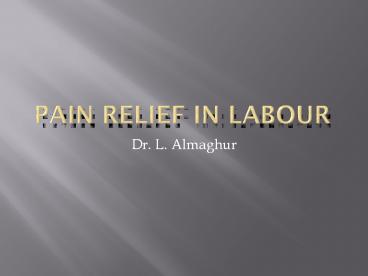Pain relief in labour - PowerPoint PPT Presentation
1 / 30
Title:
Pain relief in labour
Description:
Dr. L. Almaghur To list the different types of pain relief used in labour. To understand the advantages, disadvantages and contraindications to each methods. – PowerPoint PPT presentation
Number of Views:991
Avg rating:3.0/5.0
Title: Pain relief in labour
1
Pain relief in labour
- Dr. L. Almaghur
2
((...????? ??? ????? ?????? ?????..))
3
objectives
- To list the different types of pain relief used
in labour. - To understand the advantages, disadvantages and
contraindications to each methods.
4
Why is labour painful?
- Ischemia of uterine muscles.
- Dilatation and strengthening of the cervix.
- Stretching of the perineum in the second stage of
labour.
5
Who needs pain relief?
- respect the womans wish
6
- Panadol NSAID
X
- Simple analgesia is usually ineffective in
controlling labour pain
7
The ideal analgesic in labour
- Good analgesia.
- Easy to administer.
- Safe to the mother and baby.
- Easily reversible if necessary.
- Does NOT interfere with uterine contractions.
- Does NOT effect mobility.
8
Types of pain relief in labour
- Non-pharmacological
- Relaxation.
- TENS.
- Hypnosis.
- Acupuncture
- Hydrotherapy.
- Pharmacological
- Opiates.
- Inhalational.
- Epidural.
9
Relaxation psycoprophylaxis
- Essential in all cases.
- Antenatal classes to educate the mothers on what
to expect. - Helps mothers to cope with pain and satisfaction
with pain relief. - Carries no risk to the mother and fetus.
10
Transcutaneous nerve stimulation(TENS)
11
- Low grade electronic waves to nerves supplying
the uterus via skin electrode. - Provides good pain relief to 25 of patients.
- Not available in our hospital.
- Carries no risk to the mother and fetus.
12
Hypnosis and acupuncture
- Reported to be successful.
- Needs special skill and preparation.
- Carries no risk to the mother or fetus.
- ??? Placebo effect
- Does this matter????
13
opiates
- Pethidine and diamorphine are the commonly used
drugs. - Given inter-muscular or intravenous
- repeated when necessary.
14
Advantages
- Offers good pain relief for most patients.
- Short duration of action.
15
Disadvantage
- Nausea and vomiting. (antiemetic)
- Can cross BPB respiratory
depression in the new born. - (Nalaxone)
16
Inhalational anesthesia
- The commonest is nitrous oxide.
- Self administered to the patient via face mask.
- Given in a 50-50 mixture with oxygen (Entanox).
17
Advantages
- Provides analgesia varying from good to
ineffective. - Under control of the patient.
- Minimal adverse effects to mother and fetus.
18
Disadvantage
- not adequate for second stage, instrumental
delivery, suturing of perineum or manual removal
of placenta. - Light headedness and nausea.
- Not suitable for prolonged use.
19
Epidural anesthesia
- ??????? ???? ???
20
- Plastic catheter introduced into the epidural
space. - Catheter is left in and the analgesia is given
continuously. - Bupivican and Fentanyl
21
Advantages
- The most effective pain relief.
- The absence of pain allows enjoyment and control
of labour. - Reduces maternal fatigue and anxiety.
- Ideal in high risk pregnancies e.g. breech, MP,
and PET.
22
Disadvantage
- Restriction of movement during labour.
- Requires CTG.
- Requires resident anesthesia, cardio-respiratory
facilities and one to one care. - ?increase rate of instrumental delivery.
- Beware of urine retention.
23
Complications
- Failure 3.
- Hypotension.
- Epidural tap (headache)
- ? Back pain.
- Paralysis !!!!!!!!!.
24
Analgesia used in second stage and third stage.
- Nerve blocks.
- Spinal anesthesia.
- General anesthesia.
25
Pudendal block
- Performed by the obstetrician.
- Used for outlet forceps and vacuum delivery.
26
Spinal anesthesia
- Can be used for
- Instrumental delivery.
- Manual removal of placenta.
- Repair of third degree tear.
27
Difference between epidural and spinal
- Site.
- Onset.
- Duration.
28
Contraindications to spinal or epidural anesthesia
- Maternal refusal.
- Hypovolemia.
- Sever back deformities,
- Local infection.
- Coagulation disorders.
29
General anesthesia
- Manual removal of placenta.
- Third degree tear
30
summary
- Labour is a painful experience.
- Pharmacological and non-pharmacological method
are used for pain relief. - Each method had its advantage and disadvantage
and the choice of method depends on the stage of
labour and maternal preference.































